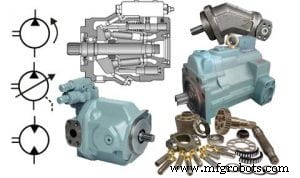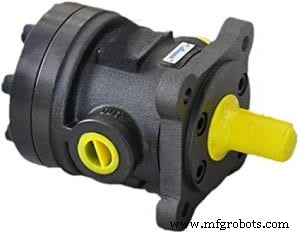Kann ich eine Hydraulikpumpe als Hydraulikmotor verwenden?
In diesem Artikel werden wir den Unterschied zwischen Hydraulikmotoren und Hydraulikpumpen besprechen. Wir werden uns auch ansehen, wie man eine Hydraulikpumpe als Hydraulikmotor verwendet.
Ein Hydraulikmotor ist eine Maschine, die hydraulischen Druck verwendet, um mechanische Leistung zu erzeugen. Eine Hydraulikpumpe ist ein Gerät, das dem hydraulischen Druck Energie entzieht, um mechanische Arbeit zu erzeugen.
Es ist wichtig zu beachten, dass ein Hydraulikmotor nur zur Erzeugung mechanischer Leistung verwendet werden kann, während eine Hydraulikpumpe sowohl zur Erzeugung als auch zur Abgabe von Hydraulik verwendet werden kann.
Was ist eine Hydraulikpumpe?
Eine Hydraulikpumpe ist ein Gerät, das Energie aus einer unter Druck stehenden Flüssigkeit umwandelt, um einen Kolben oder ein Rad zu bewegen. Es wird am häufigsten in der Technik und im Bauwesen verwendet, um Maschinen wie Pumpen, Bohrer, Sägen und Bulldozer anzutreiben.
Eine Hydraulikpumpe besteht aus einem Gehäuse, einem Pumpenkolben, einer Dichtung und einem Flüssigkeitsreservoir. Die Flüssigkeit wird vom Motor oder einer anderen Energiequelle unter Druck gesetzt und über einen Hydraulikschlauch zur Pumpe geleitet. Der Hydraulikkolben wird durch den Druckunterschied zwischen der Flüssigkeit innerhalb und außerhalb des Gehäuses bewegt.
Die Hydraulikpumpe kann für eine Vielzahl von Zwecken verwendet werden, darunter das Bewegen von Flüssigkeiten, das Heben von Objekten und das Erzeugen von Druck. Es ist ein wichtiger Bestandteil vieler Maschinen und wird häufig im Bauwesen verwendet, um Dinge wie Straßen und Dämme zu bauen.

Kann ich eine Hydraulikpumpe als Hydraulikmotor verwenden
Was ist ein Hydraulikmotor?
Ein Hydraulikmotor ist eine Art Elektromotor, der mit Druckflüssigkeit Strom erzeugt. Sie werden in einer Vielzahl von Anwendungen eingesetzt, darunter Öl- und Gasförderung, Wasserpumpen und landwirtschaftliche Geräte.
Eine der häufigsten Anwendungen für einen Hydraulikmotor ist die Öl- und Gasförderung. Das unter Druck stehende Fluid wird verwendet, um verschiedene Teile des Produktionsprozesses anzutreiben, einschließlich Bohren, Pumpen und Extraktion. Hydraulikmotoren werden auch in Wasserpumpen und landwirtschaftlichen Geräten eingesetzt.
Es gibt eine Vielzahl von Arten von Hydraulikmotoren, die alle unterschiedliche Spezifikationen haben. Einige sind für den Einsatz in Wasserpumpen konzipiert, während andere besser für die Öl- und Gasförderung geeignet sind. Es ist wichtig, den richtigen Motortyp für Ihre spezifische Anwendung zu wählen.
Einer der größten Vorteile bei der Verwendung eines Hydraulikmotors ist, dass er keinen Kraftstoff benötigt. Dadurch sind sie umweltfreundlich und können in Anwendungen eingesetzt werden, in denen Kraftstoff knapp oder schwer zu finden ist.
Wie ein Hydraulikmotor funktioniert
Eine Hydraulikpumpe ist ein Gerät, das unter Druck stehendes Wasser oder Öl verwendet, um eine rotierende Welle anzutreiben. They are most commonly used in industrial and commercial applications, such as wastewater treatment plants, grain mills, and printing presses.
Hydraulic motors work by using the pressure of the liquid to rotate the shaft. The impeller on the pump works like a fan, moving the liquid through the pump faster than it can escape. This high speed flow causes the pressure inside the pump to increase, which in turn rotates the shaft.
The first hydraulic motors were built in 1795 by Christian Huygens. Today, they are used in a wide variety of applications thanks to their reliability and efficiency.
Pros and Cons of Using a Hydraulic Pump as a Motor
A hydraulic pump can be a powerful engine for hydraulic motors, but there are some cons to consider before using one in your project. Here are the pros and cons of using a hydraulic pump as a motor:
Pros of using a hydraulic pump as a motor:
-Pumps are efficient engines, so they use less fuel than other types of motors.
-Hydraulic pumps are very reliable, so you can count on them to work even under harsh conditions.
-Pumps can produce high levels of power, making them good candidates for larger applications.
-Pumps are relatively easy to install and maintain, making them a good option for small projects.
Cons of using a hydraulic pump as a motor:
-Pumps require more maintenance than other types of motors. They may need to be oiled regularly, and they can be prone to damage if not properly cared for.
-Pumps don’t work well in cold weather environments, so they’re not ideal for applications that require low temperatures.
What are the benefits of using a hydraulic motor vs. a hydraulic pump?
There are a few benefits to using a hydraulic motor over a hydraulic pump. First, a hydraulic motor is more efficient because it uses more energy to move the same amount of fluid. Second, a hydraulic motor can be quieter since it doesn’t consume as much power. Finally, a hydraulic motor is less likely to cause damage if it fails.
On the other hand, a hydraulic pump can be more versatile since it can be used to move a variety of fluids. Additionally, a hydraulic pump can be used in places where a motor is not allowed, such as inside tight spaces.

Can I use a hydraulic pump as a hydraulic motor
How does a hydraulic motor work and are there any alternatives?
A hydraulic motor is a type of electric motor that uses hydraulic pressure to power the movement of its rotor. While hydraulic motors are most commonly found in industrial applications, there are also alternatives to using a hydraulic motor for electric motors.
One alternative is to use an electromagnetic clutch or actuator. While this option may be more expensive than using a hydraulic motor, it does have the advantage of being able to operate in a wider range of applications. Additionally, electromagnetic clutches and actuators typically have a longer lifespan than traditional hydraulic motors.
Background of the hydraulic pump and how it was used in the past History of hydraulic motors
A hydraulic pump is a machine that uses pressurized fluid to move objects. Hydraulic pumps were first used in the 1700s, and they are still used today in a variety of applications.
The history of hydraulic motors dates back to the 1700s. In 1769, Englishman James Watt developed the first steam engine, which used water pressure to power its pistons. Watt’s engine was based on the work of French engineer Nicholas-Jacques Conte.
One of the earliest applications of a hydraulic pump was in printing presses. Pressurized water was used to move the type blocks and hammers. Today, hydraulic pumps are used in a variety of industries, including mining, construction, agriculture, and manufacturing.
Schlussfolgerung
Yes, you can use a hydraulic pump as a hydraulic motor. Hydraulic pumps are designed to move large amounts of fluid, and they make an excellent choice for powering industrial machines and applications that require high levels of torque or RPMs. They also offer better performance than electric motors in some cases, making them an ideal option for certain applications.
Can I use a hydraulic pump as a hydraulic motor,please click topkitparts see more
Industrielle Ausrüstung
- Hydraulikpumpe verstehen
- 5 Gründe für den Ausfall von Hydraulikpumpen
- wie man eine Hydraulikpumpe entlüftet
- warum überhitzt meine Hydraulikpumpe
- Was ist eine radiale Hydraulikpumpe?
- Können Sie eine Hydraulikpumpe mit einem Elektromotor betreiben?
- Können Hydraulikpumpen umgebaut werden?
- Wie kann ich meine Hydraulikpumpe leiser machen?
- Hydraulikpumpen-Reparaturanzeigen
- können Sie einen Hydraulikmotor als Pumpe verwenden



